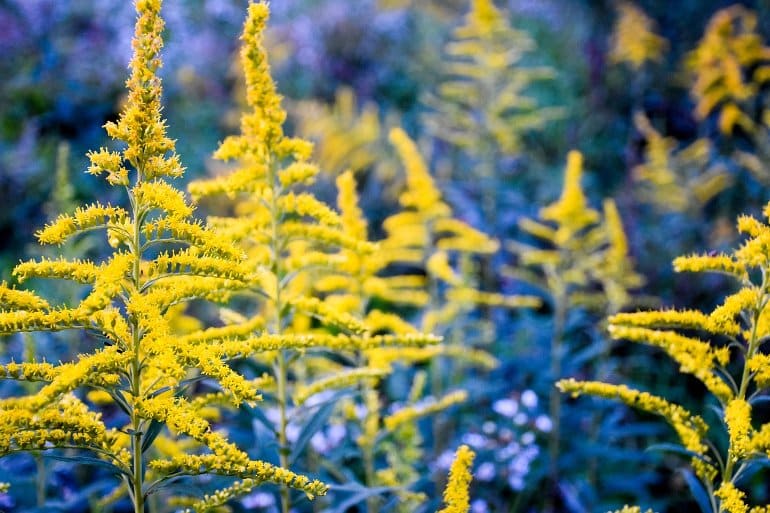Summary: Extracts from two common wildflowers, tall goldenrod and eagle fern blocked SARS_CoV_2, the virus responsible for COVID-19, from entering human cells. Researchers warn the public they should not consume the plants as a means of self-treatment against coronavirus as they can be toxic. However, the findings could provide a new avenue to develop pharmaceutical treatments for COVID-19.
Source: Emory University
Two common wild plants contain extracts that inhibit the ability of the virus that causes COVID-19 to infect living cells, an Emory University study finds.
Scientific Reports published the results—the first major screening of botanical extracts to search for potency against the SARS-CoV-2 virus.
In laboratory dish tests, extracts from the flowers of tall goldenrod (Solidago altissima) and the rhizomes of the eagle fern (Pteridium aquilinum) each blocked SARS-CoV-2 from entering human cells.
The active compounds are only present in miniscule quantities in the plants. It would be ineffective, and potentially dangerous, for people to attempt to treat themselves with them, the researchers stress. In fact, the eagle fern is known to be toxic, they warn.
“It’s very early in the process, but we’re working to identify, isolate and scale up the molecules from the extracts that showed activity against the virus,” says Cassandra Quave, senior author of the study and associate professor in Emory School of Medicine’s Department of Dermatology and the Center for the Study of Human Health.
“Once we have isolated the active ingredients, we plan to further test for their safety and for their long-range potential as medicines against COVID-19.”
Quave is an ethnobotanist, studying how traditional people have used plants for medicine to identify promising new candidates for modern-day drugs. Her lab curates the Quave Natural Product Library, which contains thousands of botanical and fungal natural products extracted from plants collected at sites around the world.
Caitlin Risener, a Ph.D. candidate in Emory’s Molecular and Systems Pharmacology graduate program and the Center for the Study of Human Health, is first author of the current paper.
In previous research to identify potential molecules for the treatment of drug-resistant bacterial infections, the Quave lab focused on plants that traditional people had used to treat skin inflammation.
Given that COVID-19 is a newly emerged disease, the researchers took a broader approach. They devised a method to rapidly test more than 1,800 extracts and 18 compounds from the Quave Natural Product Library for activity against SARS-CoV-2.
“We’ve shown that our natural products library is a powerful tool to help search for potential therapeutics for an emerging disease,” Risener says. “Other researchers can adapt our screening method to search for other novel compounds within plants and fungi that may lead to new drugs to treat a range of pathogens.”
SARS-CoV-2 is an RNA virus with a spike protein that can bind to a protein called ACE2 on host cells. “The viral spike protein uses the ACE2 protein almost like a key going into a lock, enabling the virus to break into a cell and infect it,” Quave explains.
The researchers devised experiments with virus-like particles, or VLPs, of SARS-CoV-2, and cells programmed to overexpress ACE2 on their surface. The VLPs were stripped of the genetic information needed to cause a COVID-19 infection. Instead, if a VLP managed to bind to an ACE2 protein and enter a cell, it was programmed to hijack the cell’s machinery to activate a fluorescent green protein.
A plant extract was added to the cells in a petri dish before introducing the viral particles. By shining a fluorescent light on the dish, they could quickly determine whether the viral particles had managed to enter the cells and activate the green protein.
The researchers identified a handful of hits for extracts that protected against viral entry and then homed in on the ones showing the strongest activity: Tall goldenrod and eagle fern. Both plant species are native to North America and are known for traditional medicinal uses by Native Americans.
Additional experiments showed that the protective power of the plant extracts worked across four variants of SARS-CoV-2: alpha, theta, delta and gamma.
To further test these results, the Quave lab collaborated with co-author Raymond Schinazi, Emory professor of pediatrics, director of Emory’s Division of Laboratory of Biochemical Pharmacology and co-director of the HIV Cure Scientific Working Group within the NIH-sponsored Emory University Center for AIDS Research. A world leader in antiviral development, Schinazi is best known for his pioneering work on breakthrough HIV drugs.
The higher biosecurity rating of the Schinazi lab enabled the researchers to test the two plant extracts in experiments using infectious SARS-CoV-2 virus instead of VLPs. The results confirmed the ability of the tall goldenrod and eagle fern extracts to inhibit the ability of SARS-CoV-2 to bind to a living cell and infect it.
“Our results set the stage for the future use of natural product libraries to find new tools or therapies against infectious diseases,” Quave says.
As a next step, the researchers are working to determine the exact mechanism that enables the two plant extracts to block binding to ACE2 proteins.
For Risener, one of the best parts about the project is that she collected samples of tall goldenrod and eagle fern herself. In addition to gathering medicinal plants from around the globe, the Quave lab also makes field trips to the forests of the Joseph W. Jones Research Center in South Georgia.
The Woodruff Foundation established the center to help conserve one of the last remnants of the unique longleaf pine ecosystem that once dominated the southeastern United States.

“It’s awesome to go into nature to identify and dig up plants,” Risener says. “That’s something that few graduate students in pharmacology get to do. I’ll be covered in dirt from head to toe, kneeling on the ground and beaming with excitement and happiness.”
She also assists in preparing the plant extracts and mounting the specimens for the Emory Herbarium.
“When you collect a specimen yourself, and dry and preserve the samples, you get a personal connection,” she says. “It’s different from someone just handing you a vial of plant material in a lab and saying, ‘Analyze this.'”
After graduating, Risener hopes for a career in outreach and education for science policy surrounding research into natural compounds. A few of the more famous medicines derived from botanicals include aspirin (from the willow tree), penicillin (from fungi) and the cancer therapy Taxol (from the yew tree).
“Plants have such chemical complexity that humans probably couldn’t dream up all the botanical compounds that are waiting to be discovered,” Risener says. “The vast medicinal potential of plants highlights the importance of preserving ecosystems.”
About this pharmacology and COVID-19 research news
Author: Carol Clark
Source: Emory University
Contact: Carol Clark – Emory University
Image: The image is in the public domain
Original Research: Open access.
“Botanical inhibitors of SARS-CoV-2 viral entry: a phylogenetic perspective” by Caitlin J. Risener et al. Scientific Reports
Abstract
Botanical inhibitors of SARS-CoV-2 viral entry: a phylogenetic perspective
Throughout the SARS-CoV-2 pandemic, the use of botanical dietary supplements in the United States has increased, yet their safety and efficacy against COVID-19 remains underexplored.
The Quave Natural Product Library is a phylogenetically diverse collection of botanical and fungal natural product extracts including popular supplement ingredients.
Evaluation of 1867 extracts and 18 compounds for virus spike protein binding to host cell ACE2 receptors in a SARS-CoV-2 pseudotyped virus system identified 310 extracts derived from 188 species across 76 families (3 fungi, 73 plants) that exhibited ≥ 50% viral entry inhibition activity at 20 µg/mL.
Extracts exhibiting mammalian cytotoxicity > 15% and those containing cardiotoxic cardiac glycosides were eliminated.
Three extracts were selected for further testing against four pseudotyped variants and infectious SARS-CoV-2 and were then further chemically characterized, revealing the potent (EC50 < 5 µg/mL) antiviral activity of Solidago altissima L. (Asteraceae) flowers and Pteridium aquilinum (L.) Kuhn (Dennstaedtiaceae) rhizomes.






